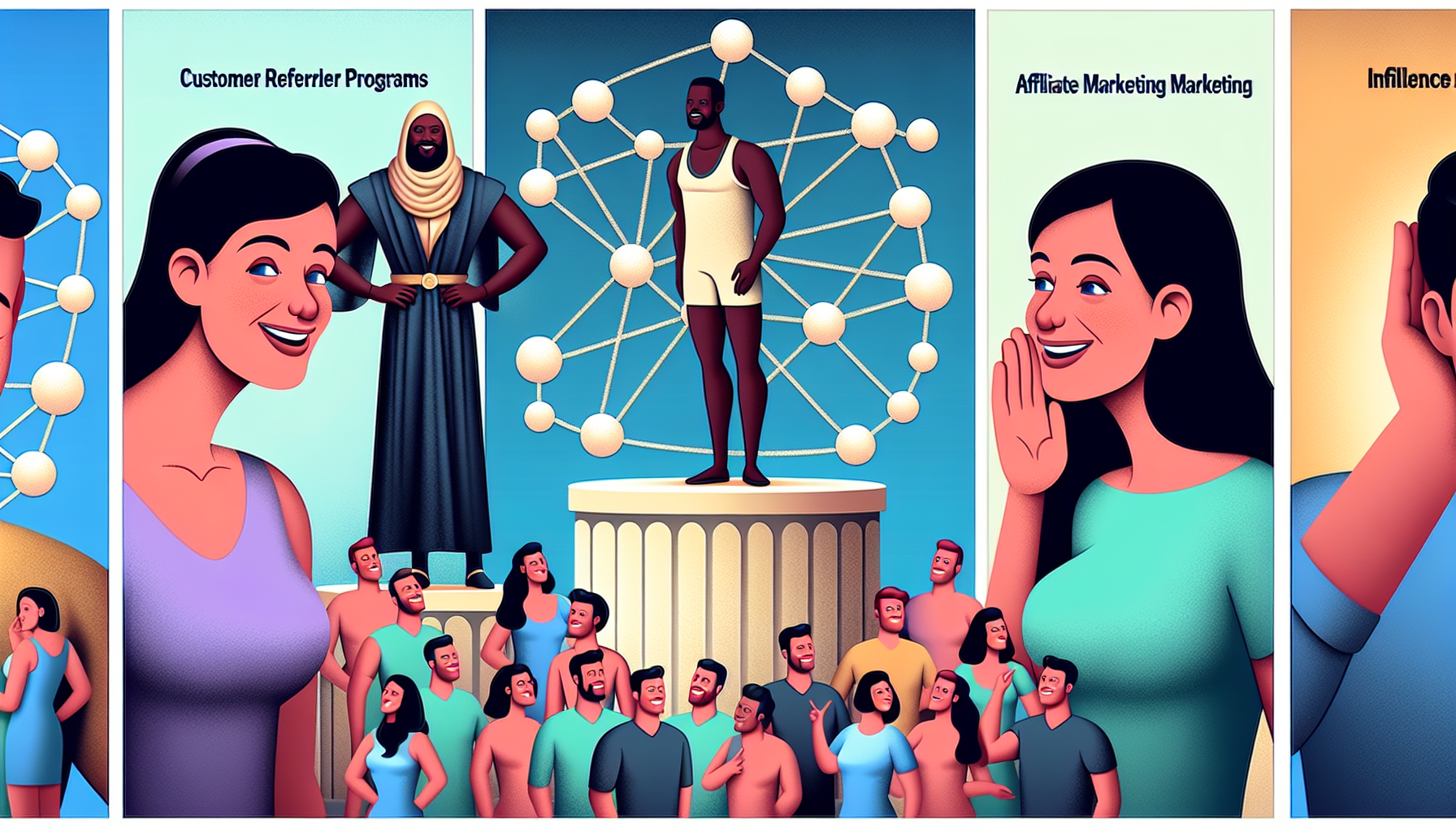
Boost Sales with Top Referral Marketing Tactics for 2024
Written by InvestGlass on .
Referral marketing harnesses the power of personal recommendations to enhance customer acquisition and loyalty. This article offers a practical walkthrough of effective referral marketing strategies that drive sales and deepen customer relationships. Expect insights on what makes these tactics work and how leading brands are successfully applying them.
Key Takeaways
- Referral marketing incentivizes customers to become brand advocates, leveraging the high trust in recommendations from people they know to acquire loyal and valuable new customers.
- Different types of referral programs, such as customer referral, affiliate, influencer, and partner programs, offer varied rewards structures tailored to business goals, customer profiles, and industry demands.
- A successful referral program relies on clear objectives, audience-tailored rewards, streamlined referral processes, and ongoing performance analysis to optimize engagement and customer acquisition.
The Power of Referral Marketing

Referral marketing is not just about getting your customers to talk about your brand. It’s about strategically incentivizing them to become your brand advocates, actively bringing in new customers who trust their recommendations. The power of this referral marketing strategy is undeniable, and the benefits of referral marketing are evident. By implementing effective referral marketing campaigns, you can tap into the fact that 84% of customers trust recommendations from people they know, leading to the acquisition of high-quality and targeted new customers. This is why referral marketing works so well for businesses.
But it doesn’t stop there. Referred customers don’t just buy your products; they are more likely to become repeat buyers, contributing to a higher customer retention rate and loyalty. They also have a greater lifetime value, which, on average, is 16% higher than non-referred customers. Next, we’ll explore the underpinning mechanisms that render referral marketing irresistibly compelling.
Trust in Word-of-Mouth
In an era where consumers are bombarded with advertisements, word-of-mouth recommendations from friends and family are like a breath of fresh air. These recommendations enjoy unparalleled trust, with 90% of consumers rating them above all other forms of advertising. This trust works wonders for brands, making consumers more likely to convert and remain loyal.
A brand that provides positive experiences is likely to receive three times more word-of-mouth referrals. When customers have their problems effectively resolved, they’ll tell four to six people about their positive experience. This organic word-of-mouth, amplified via marketing campaigns, can significantly enhance a brand’s visibility and reach among potential new customers.
Cost-Effective Customer Acquisition
Referral marketing is not just effective; it’s cost-effective. It significantly lowers the cost of acquiring new customers compared to the average cost per action on platforms like Facebook, which is $18.68. By offering incentives such as discounts or free products, businesses can motivate current customers to refer new ones, especially when operating with a limited budget.
Take Uber, for instance. Their referral program targeted frequent riders, leveraging their positive experiences to convert their contacts into new customers. This strategy quickly recovered the cost of its customer acquisition costs, with expenditure typically recouped within two months from active users.
Types of Referral Marketing Programs

Having grasped the power of referral marketing, it’s time to examine the various types of referral marketing programs. These include:
- Customer referral programs
- Affiliate marketing
- Influencer marketing
- Partner programs
Each offering unique benefits and valuable rewards.
Incentive structures in referral marketing vary, from direct cash rewards to points-based systems and tiered incentives. The choice of incentive structure depends on your business model, customer profile, and your specific objectives. We’ll now delve further into these distinct referral marketing programs.
Customer Referral Programs
At the heart of referral marketing are customer referral programs. These programs encourage existing customers to refer new ones, using points-based systems or direct rewards to drive engagement and loyalty. When customers are rewarded for their referrals, they feel valued, which strengthens their relationship with the brand and motivates them to make more referrals.
Take the example of Vitality’s referral program. With a 98% engagement rate and 49% conversion rate, it clearly demonstrates the potential of customer referral programs. By offering diverse reward structures, like IG’s dynamic rewards or T-Mobile’s unique offer of company stock, businesses can engage customers and still provide exceptional customer service and distinctive value.
Affiliate Marketing
Affiliate marketing is a vital component of referral marketing strategies, where businesses partner with affiliates who promote the brand’s products or services in exchange for a commission on the sales they generate. This strategy not only expands the brand’s reach but also ensures that marketing efforts are directly tied to sales.
However, it’s important to prevent affiliate-related referral fraud. Businesses should conduct KYB checks on partners high performing referral programs and monitor indicators such as high conversion rates or frequent chargebacks to ensure the integrity of the program.
Influencer Marketing
Influencer is digital marketing strategy that leverages the reach and trust of influential individuals in a community or industry. By collaborating with influencers who align with their brand values, businesses can authentically expand their reach.
Take Glossier, for example. By employing real local influencers through their ambassador program, they were able to expand their online sales and traffic, demonstrating the impact of social media-driven referral initiatives. When influencers act as brand ambassadors, they can drive brand advocacy and foster a sense of community around the brand.
Partner Programs
Partner programs involve establishing marketing partnerships with customer, influencer, and business advocates to increase brand awareness and generate high-quality leads. These referral partnerships are formal agreements where individuals or businesses recommend a brand to their network in exchange for rewards.
These programs often provide mutual benefits to referral customers, such as shared resources or co-marketing efforts, to amplify referral marketing results. Quality leads are standard in referral partnerships due to the pre-existing relationships and the referral partner’s firsthand experience with the product.
Designing a High-Performing Referral Program

Up next, we’ll dissect the crucial elements of creating a successful referral program. A successful referral program hinges on:
- Setting clear objectives
- Tailoring rewards to your audience
- Simplifying the referral process
- Monitoring and optimizing performance.
Maintaining brand transparency, consistency in messaging across all platforms, and having a clear call to action are key to a referral program’s success. In the upcoming subsections, we’ll take a more in-depth look into each of these components.
Set Clear Objectives
Every great journey begins with a clear destination in mind, and the same applies to your referral program. Start by understanding your business’s objectives and setting specific, measurable goals that align with these objectives, like increasing customer acquisition or sales.
The program’s objectives should be mutually understood by your business and referral partners, including the target audience and the value proposition of the product. Aligning the referral program with your company’s overall brand values and consistent messaging promotes a trustworthy and coherent brand image.
Tailor Rewards to Your Audience
A one-size-fits-all approach rarely works in marketing, and referral programs are no exception. Understanding your target audience and their motivations is critical to creating effective referral incentives that are relevant and appealing to your audience.
Whether it’s offering a range of rewards based on customer interests or offering a choice of rewards, these strategies can increase participation in the referral program. And it’s not just about the type of referral reward. Double-sided rewards, which benefit both the referrer and the referred friend, are effective at increasing both sharing and transactions.
Simplify the Referral Process
Let’s face it, no one likes complicated procedures. The simpler the referral process, the more likely potential customers are to participate. This includes everything from the call to action on your landing page to the tools customers have to activate referrals.
Consider Uber’s exceptional customer service and referral program. It uses personalized referral codes to enhance word-of-mouth marketing and make the referral experience more natural and comfortable for both referrers and new users. Similarly, Amazon Prime’s referral credits are automatically applied to the referrer’s purchases at checkout, making it convenient for the referrer to benefit from successful referrals.
Monitor and Optimize Performance
What’s measured can be improved. Identifying key performance metrics such as referral conversion rates and customer retention is crucial to evaluate the impact of the referral program on revenue and growth. Tools like Google Analytics or custom-built systems allow businesses to track referral program performance and analyze key metrics like referral numbers, conversion rates, and the effectiveness of each referral channel.
Remember, a referral program is not a set-it-and-forget-it thing. It requires continuous monitoring, analysis, and optimization. Referral software enhances program design, automates engagement emails, and provides robust data tracking, while CRM integration ensures seamless tracking of referral interactions for continuous program optimization.
Real-Life Examples of Successful Referral Marketing

After discussing the theory and strategies of referral marketing, we’ll now shift our focus to real-world examples of successful referral marketing. Uber, Amazon Prime, and Glossier are notable examples where referral marketing played a crucial role in expanding the customer base and market presence.
These examples demonstrate the potential for increased customer acquisition, customer loyalty,, and revenue growth through effective referral marketing. Referred customers:
- are 54% more likely to make another purchase
- have a 34% higher average order value
- increase their lifetime value by at least 16% compared to non-referred customers.
Uber’s Referral Program
Uber’s referral program is a great example of how effective referral marketing can be. It provided mutually beneficial rewards, granting a free ride to both the referrer and the new rider upon a successful referral. The driver referral aspect of the program was equally significant, offering substantial financial rewards to the referring driver, thus ensuring engagement and contribution to the company’s goals.
Uber targeted customers acquired their frequent riders to convert their contacts into new customers, leveraging the riders’ positive experiences to drive the program. This strategy quickly recovered the cost of customer acquisition, with expenditure typically recouped within two months from active users.
Amazon Prime’s Invite-a-Friend
Amazon Prime’s invite-a-friend program is another successful example of how referral marketing work. The program provides referral credits to the referrer when referred new members sign up for Amazon Prime and make a qualifying purchase. This requires the referred customer to click on the referrer’s link and successfully sign up for Amazon Prime, ensuring the referrer’s contribution is acknowledged.
The program stipulates that:
- The referred customer must not be an existing or returning Amazon Prime member, encouraging the acquisition of genuinely new customers.
- The referral credits earned through this program have a validity period of one year.
- The referral credits can only be used on items sold by Amazon on the Amazon.com website.
Glossier’s Ambassador Program and successful referral program
Glossier’s ambassador program is a fantastic illustration of leveraging influencer marketing in referral programs. By employing real local influencers through their ambassador program, they were able to expand their online sales and traffic, demonstrating the impact of social media-driven referral initiatives.
When influencers act as brand ambassadors, they can drive brand advocacy and foster a sense of community around the brand. Loyal customers, serving as brand ambassadors, have played a pivotal role in cementing Glossier’s presence and success in the beauty industry.
You can integrate a referral program with InvestGlass, a CRM and marketing automation platform designed to streamline your business processes. By connecting your referral program to InvestGlass, you can automate the distribution of referral links, track the progress of your referrals, and measure the success of your program through detailed analytics. This seamless integration helps ensure that your referral marketing efforts are efficient, effective, and easy to manage, leading to increased customer engagement and higher conversion rates.
Tools and Platforms for Referral Marketing

Proper implementation of a referral marketing program necessitates the right set of tools and platforms at your fingertips. Referral software solutions, social media integration, and email marketing campaigns can streamline the referral process and enhance program success.
These tools not only make it easy for customers to share referral links but also allow businesses to track and measure the success of their referral program on various platforms. Let’s further explore each of these tools and platforms.
Referral marketing strategies
Referral software solutions provide comprehensive tools for handling successful referral programs, including referral tracking, program promotion, analytics, and reporting, creating a smooth referral experience for all participants, such as the use of a referral link.
Different solutions offer different functionalities to suit a range of campaign types and business needs. Whether it’s:
- Prefinery
- Growsurf
- Viral Loops
- Referral Factory
- Referral Rock
- Friendbuy
- Invite Referrals
- Extole
Each software brings unique capabilities to the table. These solutions seamlessly integrate with CRM systems for improved customer behavior tracking, and PRM software for efficient partner relationship management, including reward payouts.
Social Media Integration
In an era where social media is integral to our lives, integrating referral marketing with social media can significantly amplify your reach. Referral offers typically include social sharing buttons, making it easy for customers to share with their networks.
Promoting the referral program effectively through multiple channels, including social media and personalizing the experience, increases engagement and participation. Social media platforms facilitate quick sharing of referral programs, especially when sharing buttons are enabled on platforms where customers are most active.
Email Marketing Campaigns to existing customers
Email marketing campaigns play a crucial role in promoting referral programs. By sending out emails to existing customers to share and adding their dropbox referral program as links or banners to emails, businesses can encourage participation in their referral programs.
Consistently promoting the referral program in email newsletters and incorporating personal touches, like customized messages, encourages more customer engagement and referrals. Segmentation techniques enable targeting of high-value, loyal customers more likely to engage with referral programs, while analytics from referral software help track the success of email campaigns in driving referrals.
Common Challenges and How to Overcome Them
As with any marketing strategy, referral marketing also presents its own set of challenges. One of the most common challenges is preventing the campaign from becoming stale over time, which can reduce its effectiveness. However, rest assured, there are strategies to surmount these challenges.
To keep a referral marketing campaign effective, it’s crucial to periodically refresh the campaign. Businesses can rejuvenate a stale referral campaign by introducing new incentives, updating the messaging, or leveraging different referral marketing ideas and channels. In the following subsections, we’ll tackle some specific challenges and their corresponding solutions.
Building Customer Trust
Building customer trust is fundamental to the success of any referral program. This involves not just offering rewarding experiences encourages customers but also ensuring the transparency and integrity of the program.
Implementing measures such as a delay period between customer conversion and the awarding of referral bonuses, alongside a manual review of transactions, can deter and detect fraudulent behavior, sustaining the referral program’s credibility. Regularly revising the terms and conditions of the referral program helps mitigate the exploitation of its features, safeguarding against fraud and misuse.
Engaging Inactive Customers
Engaging inactive customers is another challenge that many businesses face in their referral programs. However, with the right strategies, you can encourage customers to re-engage and motivate them to participate in the loyalty program once again.
Creating unique offers for inactive customers segmented by their past brand interactions can lead to a higher likelihood of re-engagement. Implementing a tiered rewards system motivates customers, as increased engagement levels lead to better rewards.
Fraud Prevention
Fraudulent activity can pose a significant challenge to referral programs. However, with the right preventive measures, businesses can protect their programs from fraudulent behavior.
One such measure is establishing a maximum reward cap in referral marketing tactics. This discourages participants from creating fraudulent referrals in hopes of earning unlimited rewards. Regularly revising the terms and conditions of the referral program helps mitigate the exploitation of its features, safeguarding against fraud and misuse.
Summary
Referral marketing is a potent tool for businesses looking to grow their existing customer base, increase brand loyalty, and boost sales. It offers a cost-effective way to acquire new customers and increase brand visibility. By designing a high-performing referral program, tailoring it to your audience, and using the right tools and platforms, businesses can maximize the benefits of referral marketing. Remember, the key to a successful referral program is building trust with your customers and continuously monitoring and optimizing the program for best results.
Frequently Asked Questions
What is the referral method?
The referral method is a marketing strategy that encourages existing customers to share your brand with others, and rewards them when a new customer makes a purchase as a result of their referral. This method leverages word-of-mouth marketing and incentivizes customers to advocate for your brand.
How do I get into referral marketing?
To get into referral marketing, start by creating shareable content, providing excellent customer service, defining your goals, and planning your campaign. You can also set KPIs, determine incentives, design a referral program, choose the right tools, and promote the program to get started. Additionally, begin with a great product, understand your customers, determine incentives, choose a top referral platform and marketing tool, invite previous customers to join the program, and make it easy for people to refer you.
Is referral marketing legal?
Referral fees are legal in certain industries, but not all. It’s important to research and ensure compliance before implementing a referral program.
What are the four types of referral marketing?
The four types of referral marketing are word-of-mouth, online reviews, social media sharing, and email. Utilizing these types leveraging referral marketing thoughtfully can lead to positive results.
Why is trust in word-of-mouth important in referral marketing?
Trust in word-of-mouth is important in referral marketing because consumers highly value recommendations from friends and family, which can increase conversion and foster brand loyalty.